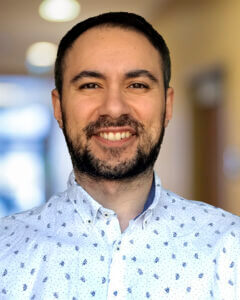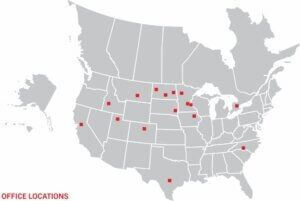It’s All about Flow: Ulteig Traffic Modeler Abdullah Kurkcu Takes His Passion for Data Science and Modeling on the Road
December 11, 2020
When Abdullah Kurkcu, Ph.D., imagines the future, he sees this perfect, efficient flow of people, cars, trucks, bicycles and scooters, communicating with each other through smart sensors, effortlessly moving from one point to another.
As Lead Traffic Modeler on the Advanced Transportation team for Ulteig, Kurkcu formulates mathematical and simulation models of transportation solutions, relating constants and variables, restrictions, alternatives, conflicting objectives and their numerical parameters.
Kurkcu performs validation and testing of models to ensure their adequacy and reformulates models as necessary. He interprets data from traffic modeling software and incorporates that data into transportation models.
Kurkcu also applies transportation methods, planning principles, and standard industry and new evaluations and analysis to support the planning, design and implementation of transportation projects for Ulteig’s clients.
Transportation systems are complex—and that complexity is where Kurkcu finds his purpose. With views of the Rockies from his home in Denver, Kurkcu geeks out on programming different scenarios based on available public data.
His joy for understanding the complexities of transportation go way back to his childhood.
“When I was a boy growing up in Istanbul, Turkey, I used to say that I wanted to be a truck driver when I grew up,” said Kurkcu, whose father was an inter-city coach bus driver.
Later, after he started college in Turkey, which was located only 24 miles from his home, Kurkcu realized one day that he wanted to dedicate himself to the science of transportation when he saw the impact of a new express lane for buses. It cut his travel time to and from college down from two hours one way to just 45 minutes.
“I remember thinking to myself, ‘There must be a better way’ while sitting on the bus going back and forth to college,” Kurkcu said.
His path to the United States started after he received a prestigious scholarship from Turkey’s Ministry of Education to study in the United States. He received his master’s degree from Florida State University and his Ph.D. from New York University where he studied intelligent transportation design.
When you watch Kurkcu describe this, his eyes light up. “I like the connections that intelligent transportation can create,” he said. “Imagine smart cars connecting with and talking to one another. Imagine a smoother flow in traffic. Imagine the vehicles driving themselves. Imagine collecting data to build an even more efficient system.”
“But this isn’t limited to just vehicles,” Kurkcu added. “Imagine the smoother flow of people walking through a city—using sidewalks, cabs and Ubers, subways or lightrail systems. Imagine a more efficient flow of people using scooters, e-bikes, regular bikes, electric skateboards. You name it—it’s all integrated. It’s all about moving people more efficiently from one location to another.”
In his work at Ulteig, Kurkcu is applying his passion for modeling to explore other types of transportation. He’s the kind of person who is always asking, “What if…?”
For example, Kurkcu recently collaborated with several transportation scientists to explore the impact of Covid-19 on pedestrian traffic in New York City and separately, bicycle use in Denver. These research papers were approved by the Transportation Review Board and Kurkcu will present his paper about the impact of Covid-19 on bicycle ridership in Denver during the TRB’s annual meeting in January.
He also worked on a research paper studying different models related to the installation of snow chain stations along I-70, from Denver up to Summit and Eagle counties where some of the most popular ski resorts (Vail, Beaver Creek, Breckenridge, Keystone) in the country are located.
In another study, Kurkcu studied the impact of snow on road traffic operations, focusing on U.S. Hwy. 285, a north-south highway that runs from Denver through Colorado’s famed mountains, down to Santa Fe, and from there, down to the Texas/Mexico border. He shared his insights and modeling methodology on the Towards Data Science channel on Medium.com.
For Kurkcu to visualize the future of a specific transportation project, he often needs to see it with his own eyes. While working on a transportation project for New Jersey, he drove a 60-mile stretch of a New Jersey highway to make sure he understood, visually, its unique flow of traffic. He also relies on video, too. For example, when studying pedestrian traffic in New York City during the early stages of Covid-19, he gained access to public video provided by the city that showed how many people were walking across specific intersections.
 “Sometimes I just have to experience it to understand it,” said Kurkcu. He explains that in order to visualize a future, asking the right questions is just as important as the data itself.
“Sometimes I just have to experience it to understand it,” said Kurkcu. He explains that in order to visualize a future, asking the right questions is just as important as the data itself.
“If the client only has enough budget to install three snow chain stations along a stretch of highway leading up to the mountains, the question changes from simply, “Where should we put them?” to “Where should we put them that offers the maximum value to users and maximum safety for all travelers?”
To learn more about Ulteig’s transportation team, visit our Transportation page.
WHAT MAKES ULTEIG DIFFERENT?
From global energy producers to locally funded cities and private developers to government agencies, the clients we serve encompass a broad range of relationships and projects. Find out why Ulteig is a leader in the engineering industry.
Contact Us
